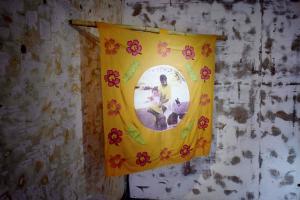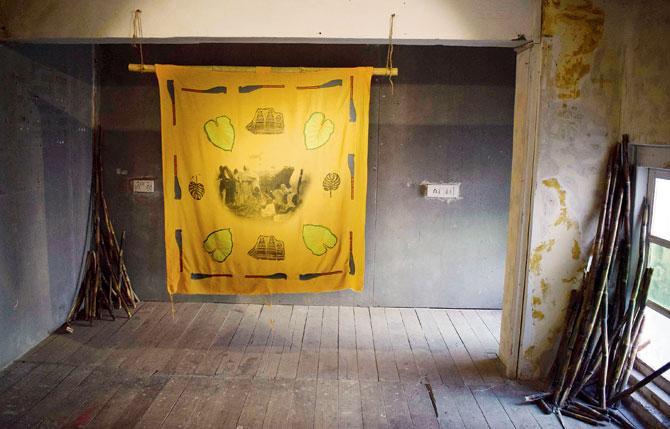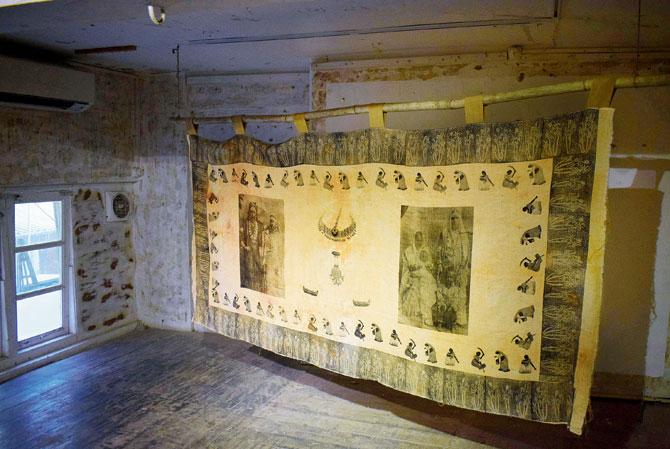A textile art exhibition by an Indo-Fijian artist weaves together the histories of indentured labour

The artwork embedded in the circle is a picture of Charan with her fua (paternal aunt).
In a small nook at Wodehouse Road, you'll learn that some histories are more powerful than others. And some are invisible, until an artist codes a powerful visual language to revive her community's collective memory. When we step into Clark House Initiative, which houses 24-year-old Indo-Fijian artist Quishile Charan's solo exhibition Ee Ghaoo Maange Acha Ho Jai (These Wounds Must Heal), we aren't surprised to see her make herself at home. The space, she tells us, ties in well with her artistic oeuvre. "My practice is a social practice. It is not commercialised work," she says.
A walk through history
ADVERTISEMENT

Inspired by the blankets her aaji makes, Charan has created two pieces with applique work on a cotton-silk blend. the artwork features an image of women taking a break in the sugarcane plantations and woodblock prints of the Leonidas — the first ship to bring indentured Indians to Fiji
The year 1879 marked the genesis of the emigration of Indian indentured labourers to Fiji — cheap labour was sourced for European-owned plantations. Charan is a fifth-generation Indo-Fijian and moved to New Zealand when she was eight years old. "The colonisers started writing us into history as the ones who brought this stuff upon ourselves and that they were actually saving us from the type of colonialism that was happening in India, so we should be thankful. There is a lot of colonial shame that is placed on us. When I was growing up, I had this ambiguous idea that something bad had happened to us, but didn't know what it exactly was. I knew we came to Fiji a long time ago for sugarcane plantation work but didn't know how deeply violent it was," she says.
Narrowing down

The exhibition Ee Ghaoo Maange Acha Ho Jai (These Wounds Must Heal) comprises four pieces of textile work. The border of this piece on khadi cloth features hand-carved woodblock print, while the inner border has watercolour motifs by artist Sancintya Mohini Simpson. The images are archival material from the Fiji Museum, which have been screen-printed. Pics/ Ashish Raje
At university, an 18-year-old Charan tried her hand at Western contemporary art, but didn't like it. She was no stranger to racism either. "I was told I wouldn't make it if I stuck to working around my cultural systems. And I said, 'Actually, I can. Just because I'm brown, we don't need to make work like that for us to be valued.'" So, she took a break from making art altogether and started reading history. "I noticed a wide difference between the way white academics were talking about indentured labour compared to Indian or Indo-Fijian academics, who gave a detailed analysis of the racism that was involved. And all the written histories predominantly featured men," she recalls.
Today, Charan's practice is more oriented towards female indentured labour, which comes with a history of sexual exploitation. Her work often fluctuates in scale — her larger works talk more broadly about indentured labour while the small-scale textiles draw up intimate experiences.
All in the family

Quishile Charan
Introduced to textiles by her aaji (paternal grandmother), she recalls being part of craft nights where women came together. She tells us, "My aaji used to teach women different craft techniques. So, it almost feels like another language to me. I really do have a voice here and I can speak freely. It's a way of including the women in my family in my work."
Charan's art has opened up conversations within the community as well as in her own family. In an increasingly globalised world that doesn't treasure traditional techniques, this feels like both a gift and a responsibility. And she even has a nickname. "They call me 'mini aaji' because I'm following in her footsteps. I remember once being in the lounge of aaji's house and I was talking about my work and she said, 'You need to tell the world about us. You need to let them know what happened to us and our ancestors.' I promised her I'd do exactly that for her."
Till: February 10, 11 am to 7 pm
At: Ground Floor, Clark House building, old Wodehouse Road, Colaba.
Call: 9820213816
Catch up on all the latest Crime, National, International and Hatke news here. Also, download the new mid-day Android and iOS apps to get the latest updates
 Subscribe today by clicking the link and stay updated with the latest news!" Click here!
Subscribe today by clicking the link and stay updated with the latest news!" Click here!







